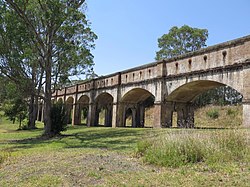Boothtown Aqueduct | |
|---|---|
 | |
| Coordinates | 33°49′51″S 150°56′18″E / 33.830950°S 150.938244°E |
| Characteristics | |
| Total length | c. 225 m (738 ft) |
| No. of spans | 22 |
| Capacity | 423 ML (14.9×106 cu ft) daily |
| History | |
| Construction start | January 1886 |
| Opened | 1888 |
| Closed | 1907 |
| Location | |
 | |
The Boothtown Aqueduct is a heritage-listed 19th-century, Victorian Romanesque style water bridge in Greystanes, Sydney, New South Wales, Australia. Established in 1888, the aqueduct was built to cross a valley to carry water from Prospect Reservoir to residents of Greater Western Sydney.
Part of the Lower Prospect Canal Reserve, the aqueduct was the longest continuous concrete work of its kind in Australia in the late 19th century and early 20th century. It was listed in November 1991 in the New South Wales Heritage Database.[1][2]
The aqueduct was constructed as a part of the Upper Nepean Scheme to convey water from the new Prospect reservoir to the new Potts Hill reservoir.
- ^ "Boothtown Aqueduct Aqueduct Valve House No 1 & 2". Archived from the original on 10 April 2018. Retrieved 10 April 2018.
- ^ 'Decades of effort bring heritage listing', Kylie Stevens, 2015